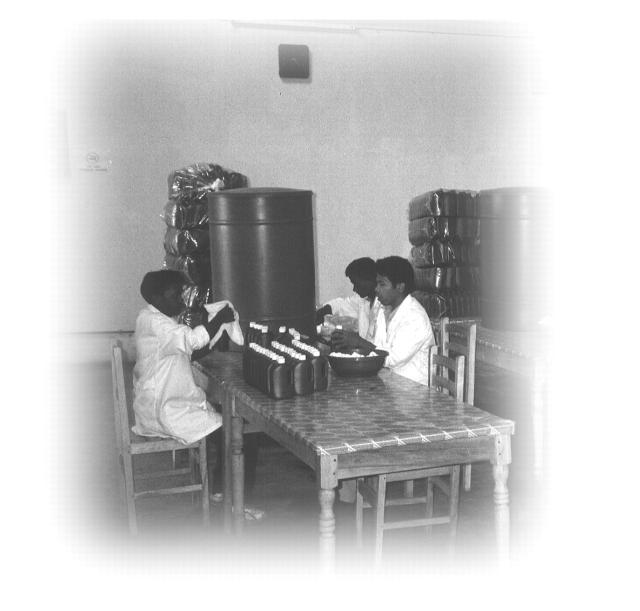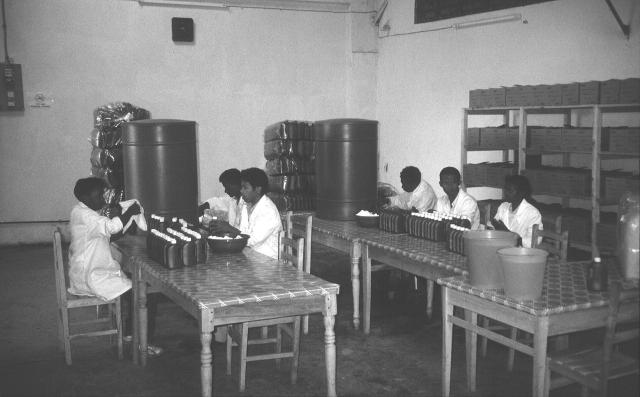Abstract
In November 1999, CARE Madagascar, Population Services International (PSI), and the Centers for Disease Control and Prevention (CDC) selected 30 poor communities in urban Antananarivo as the target population for launch of the Safe Water System. The system consists of behavior change techniques along with point-of-use treatment and safe storage of water. The project was launched in March 2000, ahead of schedule, because a cholera epidemic struck Madagascar in January.
Because of the enormous demand created by the cholera epidemic and by 3 cyclones that followed in the next 3 months, the project grew to national scale in less than a year. The combination of community mobilization and social marketing resulted in increased demand for and use of the Safe Water System.
POOR WATER QUALITY AND sanitation infrastructure are major contributing factors to high rates of diarrhea and vulnerability to cholera in Madagascar. In March 1999, cholera was detected in the country for the first time in decades and, spreading rapidly, by January 2000 reached the capital, Antananarivo. In November 1999, some of the poorest communities in urban Antananarivo, where Community Assistance for Relief Everywhere (CARE) had been working, were chosen as the target population for piloting the Safe Water System1 in Madagascar.
The implementation approach combined community mobilization by CARE Madagascar, social marketing by Population Services International (PSI), and program evaluation by the US Centers for Disease Control and Prevention (CDC). CARE's Program Mahavita had a well-established community mobilization process in 30 impoverished neighborhoods in Antananarivo. PSI had a national sales and distribution network for its other products, such as condoms. CDC drew on CARE's human and logistical resources to conduct evaluations.
In December 1999, CARE contracted PSI to socially market the Safe Water System in the areas where Mahavita was already operating. This involved local production of a 0.5% sodium hypochlorite solution packaged in a 500-mL bottle, an amount sufficient to treat approximately 2000 L of water. PSI contracted a local company to produce 20-L narrow-mouthed plastic jerry cans. The partners designed a brand name (Sûr'Eau, French for “safe water”), a logo, a label, packaging, usage instructions, and information, education, and communication materials.
In response to a major cholera epidemic that struck Antananarivo in January 2000, CARE and PSI launched the program in March 2000, 4 months ahead of schedule.
MARKETING THE SAFE WATER SYSTEM
PSI sold bottles of Sûr'Eau to wholesalers and retailers in the communities participating in the program and provided the product to CARE-trained community-based sales agents identified by neighborhood organizations. PSI designed radio and television spots and distributed brochures and posters.
PSI set an affordable consumer price for Sûr'Eau of US $0.30. At this price, the cost of treating 20 L of water was US $0.003. The price was US $0.18 for wholesalers and US $0.23 for retailers. PSI's cost recovery, excluding promotion and indirect costs, was approximately 46%.
Although the project originally was to be limited to the 30 Mahavita neighborhoods, the widening cholera epidemic resulted in demand for Sûr'Eau outside the project zone. In response, PSI and CARE broadened the intervention to cover all of Antanan-arivo. Within the first month of the project, private-sector suppliers were distributing Sûr'Eau in cholera-affected regions outside Antananarivo.
Between February 17 and April 3, 2000, three cyclones struck the east coast of Madagascar. The cyclones caused substantial wind, flood, and landslide damage, affecting 300 000 people and killing more than 200. CARE distributed more than 70 000 bottles of Sûr'Eau to affected populations. In recognition of the utility of Sûr'Eau in chol-era and cyclone emergencies, the US Agency for International Development provided funding to PSI to distribute the solution nationwide and to CARE to mobilize 4 additional project sites.
PSI monitored 4 indicators: production capacity, sales, number of retail outlets, and number of wholesalers. CARE evaluated the program's impact in Mahavita neighborhoods through baseline and follow-up surveys of a random sample of 375 households in 15 neighborhoods, stratifying them by the stage of the community mobilization process they had completed.
DISCUSSION AND EVALUATION
The Sûr'Eau Project has been characterized by rapid growth and high demand. Between March and December 2000, sales ranged from 8 000 to 80 000 bottles per month (Figure 1 ▶), with peaks during the rainy (cholera) season. PSI increased its monthly production capacity from 76 800 bottles in March 2000 to 250 000 in December 2000. Between March 2000 and January 2001, PSI's network of wholesalers increased from 78 to 725, and the number of retail outlets increased from 690 to 11 783. The remarkable success of the project was largely due to Sûr'Eau's usefulness and the project's easy deployment in response to emergencies.
FIGURE 1—
Number of bottles of Sûr'Eau water disinfectant sold in Madagascar from March through December 2000, by month.
The utilization rate of Sûr'Eau in Mahavita households was 11.2% after 6 months. Utilization in neighborhoods in the last stage of the community mobilization process was 19.7%, compared with 8.4% in those at an earlier stage (P = .01). Median free chlorine residuals in stored water were found to be 0.23 mg/L in households using Sûr' Eau, compared with 0.1 mg/L in households not using the product (P = .005).
The success of the project may have obscured several important questions. First, Sûr'Eau's sales curve was bimodal, with peaks occurring during cholera season. This finding suggests that Sûr'-Eau was perceived as a cholera prevention product rather than a general water treatment method. The challenge for PSI and CARE is to change consumer perceptions so that Sûr'Eau is used on a regular basis.
Second, because of the limited opportunity to do formative research, additional information was not obtained that might have helped with segmenting the audience, positioning the product, targeting desired behaviors, creating targeted messages, and defining appropriate communication channels.2,3 Such research could help create increased demand.
Finally, the fact that PSI has not achieved full cost recovery raises questions about the sustainability of this project. Because the objective was to provide the highest-risk populations with affordable products, full cost recovery was not possible.4 In fact, even though Sûr'Eau is sold at a very low price, economic barriers to its purchase still exist. For wide distribution of this product, therefore, partial subsidies and ongoing donor support will be necessary.
The combination of community mobilization and social marketing offers distinct advantages over social marketing alone.5 Social marketing aims to increase access to and demand for products through low price, wide commercial distribution, and information, education, and communication materials; community mobilization creates demand for health interventions from a grassroots level through participatory approaches. Simultaneously increasing access and demand through a variety of techniques should increase adoption rates.
NEXT STEPS
As the Sûr'Eau Project continues to evolve, opportunities for improving access and developing a replicable implementation model will arise. Already PSI is bringing private-sector partners into the project to take over production of Sûr'Eau so that PSI can focus on social marketing—creating demand during the non-cholera season; improving access in rural regions through the use of mobile information, education, and communication and sales teams; and reducing economic barriers through such innovations as refillable bottles, unit dose packaging, and coupons. Simultaneously, CARE is working to improve the partnership model by recruiting other nongovernmental organizations to increase demand for Sûr'Eau in high-risk populations through community mobilization and education methods. CARE is field-testing community mobilization methods in regions where the agency is converting disaster relief projects into development projects.
The combined approach of increasing access through social marketing and generating grassroots demand through community mobilization offers a promising and flexible model for development.
HIGHLIGHTS
• Because of a cholera epidemic, a planned safe-water project in Madagascar was launched 4 months ahead of schedule.
• The cholera epidemic and the occurrence of 3 cyclones increased demand for water treatment and storage products, and the project was funded for national expansion.
• CARE's community mobilization process significantly increased communities' adoption of point-of-use water treatment and storage practices.
Figure 3.
Figure 2.

Top. Sûr'Eau production and bottling facility, Antananaviro, Madagascar.
Bottom. Five-hundred-mL bottle and label used to package Sûr'Eau, a water purification solution promoted by CARE Madagascar and Population Services International. (Photo: Robert E. Quick.)
Acknowledgments
C. Dunston, D. McAfee, and R. Quick designed the project, analyzed the data, and wrote the manuscript. R. Kaiser designed the evaluation, analyzed the data, and reviewed the manuscript. D. Rakotoarison and L. Rambeloson assisted with project design and reviewed the manuscript. A. T. Hoang contributed to the writing of the report.
Resources for this research were provided by the R. W. Woodruff Foundation to CARE and the CDC Foundation, as part of the CARE–CDC Health Initiative.
We would like to thank Patricia Riley, Dr Luke Nkinsi, Reema Jossy, and Lori Buhi of the CARE–CDC Health Initiative for their support, and Caran Wilbanks for her editorial assistance. We are grateful to the Assistant Développement Communitaires of CARE Madagascar for their work in implementing and evaluating this project in Antananarivo. We would also like to recognize the Sûr'Eau Project staff of PSI Madagascar for their diligent efforts to make their products available to the population.
Peer Reviewed
Note. Use of trade names is for identification only and does not constitute endorsement by the Centers for Disease Control and Prevention or by the Department of Health and Human Services.
References
- 1.Safe Water Systems for the Developing World: A Handbook for Implementing Household-Based Water Treatment and Safe Storage Projects. Atlanta, Ga: Centers for Disease Control and Prevention; 2000. Also available at: http://www.cdc.gov/safewater. Accessed July 3, 2001.
- 2.McDermott RJ. Social marketing: a tool for health education. Am J Health Behav. 2000;24:6–10. [Google Scholar]
- 3.Stanton B, Black R, Engle P, Pelto G. Theory-driven behavioral intervention research for the control of diarrheal diseases. Soc Sci Med. 1992;35:1405–1420. [DOI] [PubMed] [Google Scholar]
- 4.Smith WA. Social marketing: an evolving definition. Am J Health Behav. 2000;24:11–17. [Google Scholar]
- 5.Bryant CA, Forthofer MS, Brown KR, Landis DC, McDermott RJ. Community-based prevention marketing: the next steps in disseminating behavior change. Am J Health Behav. 2000;24:61–68. [Google Scholar]





